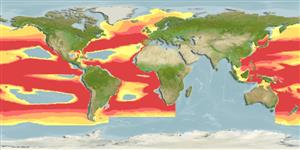Environment: milieu / climate zone / depth range / distribution range
นิเวศวิทยา
เกี่ยวกับทะเล,น้ำเค็ม สัตว์ผิวน้ำในเขตน้ำลึก; ระดับความลึก 0 - 2000 m (Ref. 86949). Deep-water
Tropical to temperate parts of all oceans.
ขนาด / น้ำหนัก / Age
Maturity: Lm ? range ? - ? cm
Max length : 10.5 cm SL (female)
Short description
สัณฐานวิทยา | ความยาวต่างๆ
ก้านครีบอ่อนที่หาง (รวม): 5-7; ก้านครีบอ่อนที่ก้น: 4 - 5. Metamorphosed females distinguished by the following characteristics: narrow snout, width of ethmoid cartilage and vomer considerably less than the distance between anterolateral tips of the lateral ethmoids and frontals; frontals short, lying posterior to the ethmoid region, dorsal margin convex; frontals separated from prootics; presence of vomerine teeth; large and nearly circular nasal foramina; presence of pterosphenoid; anterior end of illicial trough wider and shallower than the posterior end; well developed sphenotic spines; symphysial cartilage of upper jaw longer than wide; lower jaw with well developed symphysial spine; hyomandibula with double head; well developed quadrate spine, longer than articular spine; deeply notched posterior margin of opercle; long and narrow subopercle, dorsal end long and slender, tapering to a point, ventral end nearly circular; absence of first pharyngobranchial; well developed second pharyngobranchial; second hypobranchial articulates directlywith second basibranchial; caudal fin rays without internal pigmentation; illicium longer than length of escal bulb; pterygiophore of illicium cylindrical throughout length, emerging on snout from between frontal bones, anterior end exposed, posterior end concealed beneath skin; well developed first ray of dorsal fin; dorsal fin rays 5-7; anal fin rays 4-5; short and broad pectoral fin lobe, shorter than longest rays of pectoral fin; pectoral fin rays 16-19; coracoid lacking posteroventral process; simple pelvic bones, expanded distally; skin smooth and naked, without dermal spinules; darkly pigmented skin of caudal peduncle extends well past base of caudal fin (Ref. 86949).
Also mesopelagic (Ref. 10524).
Life cycle and mating behavior
วัยเจริญพันธุ์ | การสืบพันธุ์ | การวางไข่ | เซลสืบพันธ์ของเพศเมีย(ไข่) | ความดกของไข่ | ตัวอ่อน
Bertelsen, E., 1990. Oneirodidae. p. 498-507. In J.C. Quero, J.C. Hureau, C. Karrer, A. Post, and L. Saldanha (eds.) Check-list of the fishes of the eastern tropical Atlantic (CLOFETA). JNICT, Lisbon; SEI, Paris; and UNESCO, Paris. Vol. 1. (Ref. 10524)
IUCN Red List Status (Ref. 130435)
Threat to humans
Harmless
Human uses
ข้อมูลเพิ่มเติม
ชื่อสามัญชื่อพ้องกลไกการเผาผลาญพลังงานผู้ล่าการศึกษาเกี่ยวกับผลกระทบของสารประกอบทางเคมีที่เป็นอันตรายต่อสิ่งมีชีวิต ประชากร และสิ่งแวดล้อมการสืบพันธุ์วัยเจริญพันธุ์การวางไข่การรวมกลุ่มวางไข่ความดกของไข่เซลสืบพันธ์ของเพศเมีย(ไข่)Egg development
Age/SizeการเจริญเติบโตLength-weightLength-lengthLength-frequenciesความยาวต่างๆสัณฐานวิทยาตัวอ่อนพลวัตของสัตว์น้ำวัยอ่อนการทดแทนที่อุดมสมบรูณ์BRUVS
อ้างอิงการเพาะเลี้ยงสัตว์น้ำประวัติการเพาะเลี้ยงสัตว์น้ำสายพันธุ์พันธุศาสตร์ElectrophoresesอัตราพันธุกรรมโรคการแปรรูปNutrientsMass conversion
ผู้ร่วมมือรูปภาพหลายรูปStamps, Coins Misc.เสียงปลามีพิษ เช่น ปลาปักเป้าความเร็วรูปแบบการว่ายน้ำพื้นที่เหงือกOtolithsสมองวิสัยทัศน์
เครื่องมือ
Special reports
Download XML
แหล่งที่มาจากอินเตอร์เน็ต
Estimates based on models
Preferred temperature (Ref.
123201): 1 - 13.3, mean 6.7 °C (based on 2192 cells).
Phylogenetic diversity index (Ref.
82804): PD
50 = 1.0000 [Uniqueness, from 0.5 = low to 2.0 = high].
Bayesian length-weight: a=0.01995 (0.00906 - 0.04395), b=3.01 (2.83 - 3.19), in cm total length, based on all LWR estimates for this body shape (Ref.
93245).
ระดับชั้นอาหาร (Ref.
69278): 3.8 ±0.5 se; based on size and trophs of closest relatives
ความสามารถในการกลับคืนสู่ปกติ (Ref.
120179): ความสูง, เวลาต่ำสุดที่จะทำให้ประชากรเพิ่มขึ้นเป็น 2 เท่าใช้เวลาน้อยกว่า 15 เดือน (Preliminary K or Fecundity.).
Fishing Vulnerability (Ref.
59153): Low vulnerability (10 of 100).
